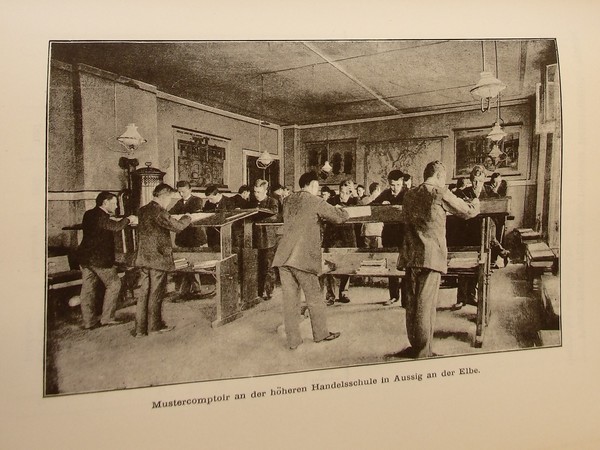Did you know that until the mid-19th century, shopkeepers, shop assistants, and accountants usually had a mere grade school education, or general education from gymnasia and secondary schools? That in Austria at that time, they had to learn everything else mainly by practice, i.e. by working directly in a shop or company? So how and when did commercial education start to modernise? This is what historians Ivan Puš from Palacký University Olomouc and Petr Kadlec from the University of Ostrava started to investigate. Their research has been supported by the Czech Science Foundation.
Thanks to the support of the Czech Science Foundation, Kadlec from the Centre for Economic and Social History at the Faculty of Arts, University of Ostrava and Puš from the Department of History, UP Faculty of Arts, have started to conduct international research on the modernisation of commercial education in the western and northern part of Austria-Hungary (the Cisleithania) in the years 1848–1918. This topic has not yet been dealt with comprehensively.
“There are no studies that would include research on the development of commercial education in such a broad time span. One of the contributions of our work will be a comparative analysis of the conditions in individual countries. The Cisleithanian area at that time included a number of regions; we will be looking at Bohemia, Moravia, Silesia, Lower Austria, including Vienna, and Galicia, which is today partly Poland and partly Ukraine. The aforementioned regions were part of one state in the period under study, but from today’s perspective, the research will have an international scope,” said Puš. He further noted on the importance of the research that at the founding of the Czechoslovak Republic in 1918, education followed up on the foundations that had been created in the 19th century. “It makes sense to identify them because at the same time, contemporary education is building on what was created after 1918 in many ways,” he added.
According to Puš, while the education of future salesmen, merchants, accountants, and other clerical professions was not institutionalised until the mid-19th century, after 1848, when the first chamber of commerce and trade was established, the state began to realise that the economy in the Czech lands and in Austria (after 1867 Austria-Hungary) needed to be modernised. At that time, the state began to take an interest in how vocational education was being provided, i.e. how the commercial, industrial trade, and agrarian schools operates, as well as trades as such. From the middle of the 19th century onwards, an array of parties began to have a say in commercial education: not only the state, but also municipal councils, merchants, professional associations, various trade councils, provincial assemblies, and later also the schools themselves, including the students’ parents. According to historian Puš, it is important to know the development of commercial education because many of the ideas and challenges that are being discussed today were already present in the debates at that time.
“For example, the perpetual discussion on the lack of tradesmen, craftsmen, and technicians because most parents prefer gymnasia and then universities for their children is age-old. In fact, it dates back to 1859, when the guilds that were emblematic of the old era disappeared. The system of vocational education that had existed for centuries was thus in decline, although a great deal of modernisation had begun. Various commercial guilds and chambers of commerce were established. Even before 1848, there were critical opinions that rich bourgeois families were sending their children to gymnasia, which were useless; even at that time, people claimed that this would lead to a lack of workers in workshops, factories, and modern plants. However, it is worth noting that we are talking about the late 19th century, so this is the pre-war era, in which university graduates made up one to two percent of society. However, even graduation from a commercial school and then a commercial academy was considered prestigious at that time,” emphasised the UP historian.
The three-year research entitled Modernisation of Commercial Education in Cisleithania in the Years 1848–1918: Manifestations, Trends, Mechanisms was supported by the Czech Science Foundation with allocated €125,000, for the period 2023–2025. Main investigator: Petr Kadlec, Ph.D., University of Ostrava; co-investigator: Mgr. Ivan Puš, Ph.D., Palacký University Olomouc.
Although we tend to ask similar questions today, education has evolved in this respect.
“We have evolved in that we have built a modern structure, a system with an order. We have three-year vocational schools and four-year commercial schools and industrial schools. Long into the second half of the 19th century, there were only summer and winter courses, Sunday schools, afternoon and evening schools, and various follow-up schools in various regions as part of primary education. It was much later when commercial day schools, commercial academies and higher commercial education became established. Most of their graduates took various clerical positions in companies, local administration and state government. Therefore, one of our goals is to capture the transformation of the education of modern clerical staff, an inconspicuous but increasingly important element in the economy and the administration of states, municipalities, and countries. Three-year schools, generally day schools, gradually began to be established only by the second half of the 19th century, and the process lasted half a century. We will be researching how society transformed in the second half of the 19th century in this regard,” said Puš. He and his colleague Kadlec will be looking for information of Austrian-wide significance in the archival sources of this region, both in the chambers of commerce and trade and the collections of school boards. They will also carry out research in the materials of individual schools, conducting partial probes into some schools, such as the Export Academy in Vienna. In addition to annual expert studies (likely in English), the research will result in a monograph.
